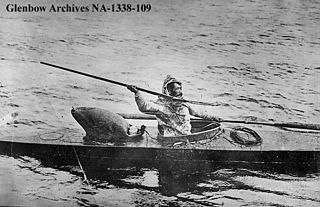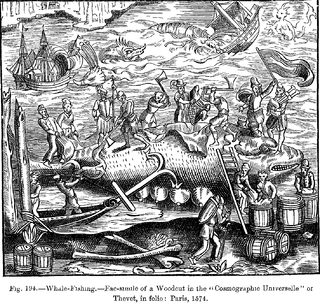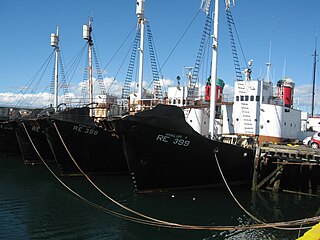This article needs additional citations for verification .(December 2013) |


A whaler or whaling ship is a specialized vessel, designed or adapted for whaling: the catching or processing of whales.
This article needs additional citations for verification .(December 2013) |


A whaler or whaling ship is a specialized vessel, designed or adapted for whaling: the catching or processing of whales.
The term whaler is mostly historic. A handful of nations continue with industrial whaling, and one, Japan, still dedicates a single factory ship for the industry. The vessels used by aboriginal whaling communities are much smaller and are used for various purposes over the course of the year.
The whale catcher was developed during the Steam-powered vesselage , and then driven by diesel engines throughout much of the twentieth century. It was designed with a harpoon gun mounted at its bow and was fast enough to chase and catch rorquals such as the fin whale. At first, whale catchers either brought the whales they killed to a whaling station, a settlement ashore where the carcasses could be processed, or to its factory ship anchored in a sheltered bay or inlet. With the later development of the slipway at the ship's stern, whale catchers were able to transfer their catch to factory ships operating in the open sea. [1]
Previous to that was the whaleship of the 16th to early 20th centuries, driven first by sail and then by steam. The most famous example is the fictional Pequod in Moby-Dick , based on the whaling industry in Nantucket. Whaleships carried multiple whaleboats, open rowing boats used to chase and harpoon the whale. The whaleship would keep watch from the crowsnest, so it could sail to the signal and lash the dead whale alongside. Then the work of flensing (butchering) began, to separate the whale into its valuable components. The blubber was rendered into whale oil using two or three try-pots set in a brick furnace called the tryworks. Spermaceti was especially valuable, and as sperm whaling voyages were several years long, the whaling ships were equipped for all eventualities.
There have also been vessels which combined chasing and processing, such as the bottlenose whalers of the late 19th and early 20th century, and catcher/factory ships of the modern era.
The crews of whaling vessels fought small skirmishes for the control of the Spitsbergen whale fishery between 1613 and 1638. The Dutch were the first Europeans to visit Svalbard, and this gave a head start to whaling in the Dutch Republic.
In the late 18th and early 19th century, the owners of whalers frequently armed their vessels with cannons to enable the vessels to protect themselves against pirates, and in wartime, privateers. Weapons were also carried on vessels visiting Pacific islands for food, water, and wood in order to defend themselves from the sometimes hostile inhabitants. At the outbreak of the French Revolutionary Wars in 1793, British privateers captured several French whalers, among them Necker and Deux Amis, [2] and Anne. [3] Dutch privateers captured Port de Paix and Penn. [4] At the time, many French whalers transferred to the American flag,[ citation needed ] the United States being neutral in the Anglo-French war.
Some whaleships also carried letters of marque that authorized them to take enemy vessels should the opportunity arise. In July 1793 the British armed whaleship Liverpool, of 20 guns, captured the French whaleship Chardon. However, the French crew succeeded in retaking their vessel. [5] Also that year, an armed British whaleship captured the French whaleship Hébé in Walvis Bay. [6]
During the War of 1812, the U.S. Navy captured two British whaleships, Atlantic and Seringapatam, and used them as warships.
During World War II, the Norwegian and later British Royal Navies requisitioned a number of whalers for use in a variety of functions such as minesweeping, search and rescue, and anti-submarine warfare. [7] Ten Allied vessels categorized as whalers were lost in the war. [8]

Since the 1982 moratorium on commercial whaling, few countries still operate whalers, with Norway, Iceland, and Japan among those still operating them. Of those, the Nisshin Maru of Japan's Institute of Cetacean Research (ICR) is the only whaling factory ship in operation.
As compared to whaling before and during the 19th century, which was executed with handheld harpoons thrown from oar-powered whaleboats (depicted most famously in Herman Melville's Moby Dick), whaling since the 1900s has been quite different. Whale oil, which fossil-fuel based alternatives has supplanted, is no longer the primary commercial product of whaling. Whaling is now done for whale meat for the relatively small culinary market. (Norwegian whalers account for about 20% of whales caught and Japanese whalers for about 60%.) Harpoon cannons, fired from harpoon ships with displacement in the hundreds of tons, are now universally used for commercial whaling operations. These motorized ships are able to keep up with the sleeker and fast-swimming rorquals such as the fin whale, that would have been impossible for the muscle-powered rowboats to chase, and allow whaling to be done more safely for the crews.
The use of grenade-tipped harpoons has greatly improved the effectiveness of whaling, allowing whales to be killed often instantaneously as compared to the previous method in which whales bled to death, which took a long time and left the whale to thrash around in its death throes. These harpoons inject air into the carcass to keep the heavier rorqual whales hunted today from sinking. However, the harpoon-cannon is still criticized for its cruelty as not all whales are killed instantly; death can take from minutes to an hour.
Japan is currently the only country that engages in whaling in the Antarctic, which is now under the protection of the International Whaling Commission as the Southern Ocean Whale Sanctuary. The area formerly saw large scale commercial whaling operations by numerous countries before the moratorium. The three Japanese harpoon ships of the ICR serve a factory ship that processes the catch on board and preserves it on site in refrigerators, allowing the long endurance whaling missions. These whaling operations, which are claimed by Japan to be for research purposes, sell the meat from these operations on the market, allowed under the current moratorium to defer research costs. They are highly controversial, and are challenged by anti-whaling parties as being merely a disguise for commercial whaling. The Sea Shepherd Conservation Society has clashed with the Japanese whalers in the Antarctic in confrontations that have led to international media attention and diplomatic incidents.

The most famous fictional whaling ship is the Pequod from the novel Moby-Dick .[ citation needed ]

Moby-Dick; or, The Whale is an 1851 novel by American writer Herman Melville. The book is the sailor Ishmael's narrative of the maniacal quest of Ahab, captain of the whaling ship Pequod, for vengeance against Moby Dick, the giant white sperm whale that bit off his leg on the ship's previous voyage. A contribution to the literature of the American Renaissance, Moby-Dick was published to mixed reviews, was a commercial failure, and was out of print at the time of the author's death in 1891. Its reputation as a Great American Novel was established only in the 20th century, after the 1919 centennial of its author's birth. William Faulkner said he wished he had written the book himself, and D. H. Lawrence called it "one of the strangest and most wonderful books in the world" and "the greatest book of the sea ever written". Its opening sentence, "Call me Ishmael", is among world literature's most famous.

A harpoon is a long spear-like projectile used in fishing, whaling, sealing, and other hunting activities to shoot, kill, and capture large fish or marine mammals such as seals, sea cows and whales. It accomplishes its task by impaling the target animal and securing it with barb or toggling claws, allowing the fishermen or hunters to use an attached rope or chain to pull and retrieve the animal. A harpoon can also be used as a ranged weapon against other watercraft in naval warfare.

Japanese whaling, in terms of active hunting of whales, is estimated by the Japan Whaling Association to have begun around the 12th century. However, Japanese whaling on an industrial scale began around the 1890s when Japan started to participate in the modern whaling industry, at that time an industry in which many countries participated.

This article discusses the history of whaling from prehistoric times up to the commencement of the International Whaling Commission (IWC) moratorium on commercial whaling in 1986. Whaling has been an important subsistence and economic activity in multiple regions throughout human history. Commercial whaling dramatically reduced in importance during the 19th century due to the development of alternatives to whale oil for lighting, and the collapse in whale populations. Nevertheless, some nations continue to hunt whales even today.

A whaleboat is a type of open boat that was used for catching whales, or a boat of similar design that retained the name when used for a different purpose. Some whaleboats were used from whaling ships. Other whaleboats would operate from the shore. Later whaleboats usually could operate under sail or oar - American whaling crews in particular obtained better results by making their first approach to a whale under sail, then quickly unstepping the mast and using oars thereafter.

Essex was an American whaling ship from Nantucket, Massachusetts, which was launched in 1799. On November 20, 1820, while at sea in the southern Pacific Ocean under the command of Captain George Pollard Jr., the ship was attacked and sunk by a sperm whale. About 2,000 nautical miles (3,700 km) from the coast of South America, the 20-man crew was forced to make for land in three whaleboats with what food and water they could salvage from the wreck.

Pequod is a fictional 19th-century Nantucket whaling ship that appears in the 1851 novel Moby-Dick by American author Herman Melville. Pequod and her crew, commanded by Captain Ahab, are central to the story, which, after the initial chapters, takes place almost entirely aboard the ship during a three-year whaling expedition in the Atlantic, Indian and South Pacific oceans. Most of the characters in the novel are part of Pequod's crew.

In the Heart of the Sea: The Tragedy of the Whaleship Essex is a book by American writer Nathaniel Philbrick about the loss of the whaler Essex in the Pacific Ocean in 1820. The book was published by Viking Press on May 8, 2000, and won the 2000 National Book Award for Nonfiction. It was adapted into a film of the same name, which was released in December 2015.

Whaling in Iceland began with spear-drift hunting as early as the 12th century, and continued in a vestigial form until the late 19th century, when other countries introduced modern commercial practices. Today, Iceland is one of a handful of countries that formally object to an ongoing moratorium established by the International Whaling Commission in 1986, and that still maintain a whaling fleet. One company remains concentrated on hunting fin whales, largely for export to Japan, while the only other one previously hunted minke whales for domestic consumption until 2020, as the meat was popular with tourists. In 2018, Hvalur hf whalers killed a rare blue whale/fin whale hybrid.
Whaling in Norway involves hunting of minke whales for use as animal and human food in Norway and for export to Japan. Whale hunting has been a part of Norwegian coastal culture for centuries, and commercial operations targeting the minke whale have occurred since the early 20th century. Some still continue the practice in the modern day, within annual quotas.

The Nisshin Maru (日新丸) was the primary vessel of the Japanese whaling fleet and was the world's only whaler factory ship. It was the research base ship for the Institute of Cetacean Research for 2002 to 2007. It had a tonnage of 8,145 GT and is the largest member and flagship of the five-ship whaling fleet, headed by leader Shigetoshi Nishiwaki. The ship was based in Japan in Shimonoseki harbor and was owned by Tokyo-based Kyodo Senpaku, which is a subsidiary of the Institute of Cetacean Research.
A Nantucket sleighride is the dragging of a whaleboat by a harpooned whale while whaling. It is an archaic term from the early days of open-boat whaling, when the animals were harpooned from small open boats. Once harpooned, the whale, in pain from its wound, attempts to flee, but the rope attached to the harpoon drags the whalers' boat along with it. The term refers to Nantucket, Massachusetts, the center of the American whaling industry; as well as the speed associated with riding in a horse-drawn sleigh. The term wasn't used by whalemen themselves, but was probably invented by a late 19th-century journalist.

Sperm whaling is the human practice of hunting sperm whales, the largest toothed whale and the deepest-diving marine mammal species, for the oil, meat and bone that can be extracted from the cetaceans' bodies.

Anti-whaling refers to actions taken by those who seek to end whaling in various forms, whether locally or globally in the pursuit of marine conservation. Such activism is often a response to specific conflicts with pro-whaling countries and organizations that practice commercial whaling and/or research whaling, as well as with indigenous groups engaged in subsistence whaling. Some anti-whaling factions have received criticism and legal action for extreme methods including violent direct action. The term anti-whaling may also be used to describe beliefs and activities related to these actions.

Two Brothers was a Nantucket whaleship that sank on the night of February 11, 1823, off the French Frigate Shoals. The ship's captain was George Pollard, Jr., former captain of the famous whaleship Essex. The wreck was discovered in 2008 by a team of marine archaeologists working on an expedition for the National Oceanic and Atmospheric Administration in the Papahānaumokuākea Marine National Monument. She is thought to have been built in 1804 by Joseph Glidden in Hallowell, Maine.

Moby Dick is a 1998 American television miniseries directed by Franc Roddam, written by Roddam, Anton Diether, and Benedict Fitzgerald, and executive produced by Francis Ford Coppola. It is based on Herman Melville's 1851 novel of the same name. It was filmed in Australia in 1997 and first released in the United States in 1998. The miniseries consisted of two episodes, each running two hours with commercials on March 15 and 16 of 1998 on the USA Network. This is Gregory Peck's final on-screen role.
Thomas Welcome Roys was an American whaleman. He was significant in the history of whaling in that he discovered the Western Arctic bowhead whale population and developed and patented whaling rockets in order to hunt the faster, more powerful species that had until then eluded European whalers.
George Pollard Jr. (1791–1870) was the captain of the whalers Essex and Two Brothers, both of which sank. Pollard's life, including his encounter with the sperm whale that sank Essex, served as inspiration for Captain Ahab, the whale-obsessed character in Herman Melville's Moby-Dick.

Commercial whaling in Britain began late in the 16th century and continued after the 1801 formation of the United Kingdom and intermittently until the middle of the 20th century.